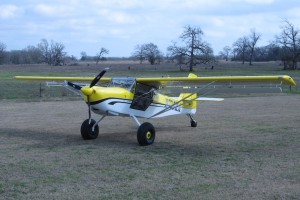My analysis of the weather on Monday was correct. It has been lousy since shortly after I made my first flight. I looked back at the hourly reports and there was a three hour window on Monday evening when the winds died down before the low clouds rolled in. By an hour after sunset the ceilings were low and by morning the winds had picked up. I am so glad that I got that short flight in. There were so many details that could only be evaluated by actually taking to the air and now that I have done it I feel very relieved and I’m still smiling. No joke!
I went back out on Tuesday evening to take a close look at everything and there were no issues. A few items needed tweaking but that was it. I put her all back together and cleaned her all up so she’ll be ready to fly again. Then for the first time in six weeks, yesterday evening, I did not go to the airport. I actually went home after work and relaxed. For the past six weeks my life daily routine was; wake up, go to work, go to the airport, go home, go to sleep. Repeat. On the weekends I spent 8-10 hours at the airport each day. But, it was all worth it. The weather is looking really good for the weekend I am looking forward to lots of flying.
I had a chance to look at a video of my take off on Monday. It was a crazy few seconds and my instincts served me well but I was not sure exactly how the the takeoff progressed. From the video I can see what happened very clearly. When I applied full power I held the stick back for about two or three seconds, that I remember. Then I raised the tail by moving the stick forward and in the tailwheel airplanes I am used to flying I can then accelerate in a level attitude for a few seconds before pulling the stick back at bit to raise the nose at which point the airplane becomes airborne. But, it seems that as soon as I raised the tail on Monday my airplane had the speed and attitude needed to become airborne and it happened very quickly . Much more quickly than I have ever experienced and before I had completely lowered the nose. An instant later I saw the ground dropping away, glanced at the airspeed indicator, and lowered the nose a bit. Our airspeed was 50 mph and I wanted to climb at 65. We were climbing at 1400 feet per minute! I also overcorrected a little bit in roll just after takeoff but got he hang of it pretty quickly. Shortly after we were stabilized and climbing at 65 mph it finally struck me that I was now FLYING the airplane that I spent over 15 years building. I’ll never forget that moment.
 Flying N90HS on her first flight was a very important to me. To prepare myself for that flight I had obtained several hours of flight training. I received 4.3 hours of instruction in the Kitfox Light Sport airplane pictured here. This is the model that is available currently either in kit form or ready to fly. It is a little larger and quite a bit heavier than my plane. It is not that the plane is all that much heavier but I was flying it with an instructor instead of solo. I have also been flying a 1946 Aeronca Champ. Again, with two on board and with a less powerful engine than my plane has. I have flown a friend’s Kitfox Model 4 but that was also with two on board. I was flying my airplane without the wing extensions. In this configuration my flaperons are full span and the roll response is quicker than my friends Model 4 or the Kitfox Light Sport. So the combination of lighter weight and increased roll response resulted in an airplane somewhat different from anything I had flown before. I am a part time flight instructor so I have become used to the unexpected and as I mentioned before, my instincts served me well and the flight was a success.
Flying N90HS on her first flight was a very important to me. To prepare myself for that flight I had obtained several hours of flight training. I received 4.3 hours of instruction in the Kitfox Light Sport airplane pictured here. This is the model that is available currently either in kit form or ready to fly. It is a little larger and quite a bit heavier than my plane. It is not that the plane is all that much heavier but I was flying it with an instructor instead of solo. I have also been flying a 1946 Aeronca Champ. Again, with two on board and with a less powerful engine than my plane has. I have flown a friend’s Kitfox Model 4 but that was also with two on board. I was flying my airplane without the wing extensions. In this configuration my flaperons are full span and the roll response is quicker than my friends Model 4 or the Kitfox Light Sport. So the combination of lighter weight and increased roll response resulted in an airplane somewhat different from anything I had flown before. I am a part time flight instructor so I have become used to the unexpected and as I mentioned before, my instincts served me well and the flight was a success.
